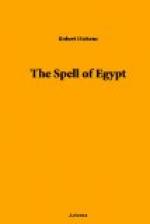The restored apricot-colored columns outside look unhappily suburban when you are near them. The white columns with their architraves are more pleasant to the eyes. The niches full of bright hues, the arched chapels, the small white steps leading upward to shallow sanctuaries, the small black foxes facing each other on little yellow pedestals—attract one like the details and amusing ornaments of a clever woman’s boudoir. Through this most characteristic temple one roves in a gaily attentive mood, feeling all the time Hatshepsu’s fascination.
You may see her, if you will, a little lady on the wall, with a face decidedly sensual—a long, straight nose, thick lips, an expression rather determined than agreeable. Her mother looks as Semitic as a Jew moneylender in Brick Lane, London. Her husband, Thothmes II., has a weak and poor-spirited countenance—decidedly an accomplished performer on the second violin. The mother wears on her head a snake, no doubt a cobra-di-capello, the symbol of her sovereignty. Thothmes is clad in a loin-cloth. And a god, with a sleepy expression and a very fish-like head, appears in this group of personages to offer the key of life. Another painting of the queen shows her on her knees drinking milk from the sacred cow, with an intent and greedy figure, and an extraordinarily sensual and expressive face. That she was well guarded is surely proved by a brave display of her soldiers—red men on a white wall. Full of life and gaiety all in a row they come, holding weapons, and, apparently, branches, and advancing with a gait of triumph that tells of “spacious days.” And at their head is an officer, who looks back, much like a modern drill sergeant, to see how his men are marching.
In the southern shrine of the temple, cut in the rock as is the northern shrine, once more I found traces of the “Lady of the Under-World.” For this shrine was dedicated to Hathor, though the whole temple was sacred to the Theban god Amun. Upon a column were the remains of the goddess’s face, with a broad brow and long, large eyes. Some fanatic had hacked away the mouth.
The tomb of Hatshepsu was found by Mr. Theodore M. Davis, and the famous Vache of Deir-el-Bahari by Monsieur Naville as lately as 1905. It stands in the museum at Cairo, but for ever it will be connected in the minds of men with the tiger-colored precipices and the Colonnades of Thebes. Behind the ruins of the temple of Mentu-Hotep III., in a chapel of painted rock, the Vache-Hathor was found.




